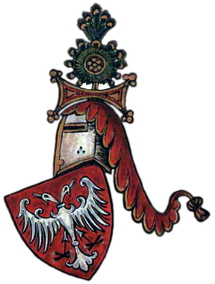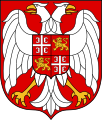Coat of arms of Serbia
| Coat of arms of Serbia | |
|---|---|

|
|
| Versions | |
 Small coat of arms |
|
| Details | |
| Introduced | 1882; again in 2004 |
The coat of arms of Serbia shows in its coat of arms in red a silver double-headed eagle with gold reinforcement and a breast shield , which in red shows a silver Greek cross , angled with four standing fire steels open to the edge of the shield (so-called " Serbian cross "). Below each eagle catch a golden lily . On the shield rests a golden crown with the orb in the crown tip. The coat of arms is adorned with a coat of arms lined with a coat of arms, with a golden fringe and the same crown as on the shield.
The cross is a symbol of the people, the eagle is a symbol of the state. It seems interesting that the Republic of Serbia, like Georgia and Hungary, has the coat of arms of a kingdom (in the case of Serbia, the coat of arms and the royal crown from the time of the House of Obrenović ).
The double-headed eagle and cross symbol were adopted from the Byzantine Empire; the fire steels resemble the Cyrillic letter "C" (= Latin "S"), which was adopted from the Byzantine letter Sigma . As letters they are now interpreted as a monogram for Serbia (Cyrillic Cрбиja ) or as an abbreviation for the Serbian national saying Samo sloga Srbina spasava (Cyrillic Само слога Србина спасава , German only unity saves the Serbs ).
history
Double-headed eagle

The silver, double-headed eagle appeared in Serbia in the 12th century at the earliest under Stefan Nemanja . Older documents are not known. However, the color of the double-headed eagle was not precisely defined, so that it was later depicted among the Nemanjids in both silver, gold, red and black. Traditional historians believe that Stefan Nemanja simply imitated the Byzantine Empire . In the Byzantine Empire, the double-headed eagle stood for imperial unity or ecumenism of East and West as well as for the unity of the heavenly with the earthly world. It was also an imperial symbol and only reserved for emperors. By adopting the double-headed eagle, Nemanja is said to have symbolized that he saw himself no less than the Byzantine emperors. In the 15th century the double-headed eagle crystallized in white on a red field as the coat of arms of Serbia. In recent history, the double-headed eagle became the official national coat of arms of Serbia with the proclamation of the Kingdom of Serbia in 1882. The white ( heraldic silver ) double-headed eagle is shown together with the Serbian cross on the chest and also on a red shield.
Heraldic shield
The breast shield of the double-headed eagle shows a silver tetragram cross in red , i.e. a Greek bar cross , which is accompanied in the corners of the crossing by four standing fire steels open to the edge of the shield . Serbian rulers took over the symbol from the Byzantine ruling dynasty of the palaeologists , who used the tetragram cross as a symbol of rule between 1259 and 1453. Already the Byzantine author Pseudo-Kodinos described the tetragrammatic cross in his work De officiis from around 1347 to 1368 as "the usual imperial banner [ flamoulon ], ie the cross with a firing bolt". According to one interpretation, the fire steels in the symbol of the Byzantine imperial dynasty of the palaeologists are originally said to have been used as the Greek letter Beta for the abbreviation Βασιλεύς Βασιλέων Βασιλεύων Βασιλευόντων (= Vassileus Vassileon Vassilevon Vassilevon) who ruled over the kings of the kings Vasileusin. After the Greek designation tetragram for the name of God or the letter Beta, it is therefore called the tetragram cross or beta cross.
Some historians believe that this cross symbol was already used by the Mrnjavčević , but there is no historically relevant evidence for this thesis. The symbol of the cross appears for the first time under Stefan Lazarević , who was awarded the despot title in 1402 by the Byzantine emperor John VII , the highest Byzantine title after that of emperor. The oldest known depiction can be found in the Visoki Dečani monastery , created around 1397 during Lazarević's reign. Lazarević is often said to have introduced it. Possibly the flag of the palaeologists was also adapted.
Since the nation-building in the 19th century, the fire steels are escutcheon because of their similarity in the vernacular in Cyrillic С letters (like the Latin letter S reinterpreted) that the initials of alliteration and unofficial crest currency С амо с лога С рбина с пасава (Only Eintracht saves the Serbs) should form. It came from the influential ideological and political leader of the Serbs in the Habsburg monarchy, Svetozar Miletić (1826–1901) from Vojvodina , who gave his speeches with the words “Složno braćo, samo složno! Samo sloga Srbina spasava! ”(“ In harmony, brothers, only in harmony! Only in harmony saves the Serbs! ”) Ended. There are also other interpretations: Under Lazarević, for example, the letters may have stood for “Stefan” or four times for the first letter of “Srbija” (Serbia).
The constitution of the Principality of Serbia of 1835 ( Sretanjski ustav ) determined: "The coat of arms of the Serbian people shows a cross on a red field, and between the arms of the cross a fire steel turned away from the cross." The constitution of the Kingdom of Serbs, Croats and Slovenes from 1921 said: "[...] the Serbian [coat of arms]: a white cross on a red shield with a fire steel in each thigh."
Through the connection as a common figure of the Serbian coat of arms, it has become a national symbol of the Serbs as the so-called "Serbian cross" .
Historical coat of arms
Coat of arms of the Serbian despots
Principality of Serbia (1835–1882)
Kingdom of Serbia (1882-1918)
Coat of arms of the Kingdom of Yugoslavia (1918–1941)
Serbia under German military administration (1941–1945)
Coat of arms of the Socialist Republic of Serbia (1947–1992) and the Republic of Serbia (1992–2004)
Coat of arms of Serbia and Montenegro (1993-2006)
See also
- Flag of Serbia
- Coat of arms of the Socialist Republic of Serbia
- Coat of arms of Serbia and Montenegro
literature
- Karl-Heinz Hesmer, Matthias Herkt, Petra Niebuhr-Timpe (eds.): Chronicle ready to hand. Flags and coat of arms of the world. (With current country information) . Chronik-Verlag, Gütersloh et al. 2008, ISBN 978-3-577-14537-4 .
- Birgitta Gabriela: Discover Serbia. On the way to hidden monasteries and cultural treasures . Trescher, Berlin 2006, ISBN 3-89794-066-3 , ( Trescher series of trips ).
- Aleksandar V. Solovjev: Les emblemes heraldiques de Byzance et les slaves . In: Seminarium Kondakovianum . No. 7 , 1935, ZDB -ID 401738-9 , p. 119-164 .
Web links
- Official description of the coat of arms of the Republic of Serbia ( Memento of June 8, 2009 in the Internet Archive ) ( Serbian )
Individual evidence
- ↑ Discover Serbia. On the way to hidden monasteries and art treasures, Birgitta Gabriela Hannover, Trescher Verlag, 2006, ISBN 3-89794-066-3
- ^ So the view of the French heraldist Vuitton; Accepted by European heraldry at the latest from the 18th century.
- ↑ Aleksandar V. Solovjev: Les emblemes héraldiques de Byzance et les slaves . In: Seminarium Kondakovianum . No. 7 , 1935, pp. 119-164, here pp. 161-162 .
- ↑ Pseudo-Kodinos: De officiis . = Traité des offices. Introduction, texte et traduction by Jean Verpeaux. Ed .: Cente National de la Recherche Scientifique (= Les monde byzantin . Volume 1 ). 1966, ISSN 0544-7704 , p. 167 , lines 17-23 .
- ^ Günther Schuhmann: The "Empress of Constantinople" in Nuremberg. On the stay of the paleologist Zoe on her journey from Rome to Moscow in 1472. In: Horst Heldmann (Ed.): Archives and historical research. Studies on Franconian and Bavarian history. Fridolin Solleder for his 80th birthday. Schmidt, Neustadt (Aisch) 1966, pp. 148-174, here p. 166, footnote.
- ↑ Robert Ousterhout: Symbols of Power. Medieval heraldry between East and West. In: Margit Mersch, Ulrike Ritzerfeld (ed.): Latin-Greek-Arabic encounters. Cultural diversity in the Mediterranean region of the late Middle Ages (= Europe in the Middle Ages. 15). Akademie Verlag, Berlin 2009, ISBN 978-3-05-004664-8 , pp. 91–110.
- ^ Charles Boutell: Boutell's Manual of Heraldry . Revised and illustrated by V. Wheeler-Holohan. F. Warne and Company, London et al. a. 1931, p. 193 (“[…] representations of the old steels for striking light from a flint, but on account of their likeness to the Slavonic letter 'S' they came popularly to stand for the phrase, 'Samo Sloga Srbina Spasava'.”).
- ↑ Article 4 of the Constitution of the Principality of Serbia from 1835.
- ↑ Article 2 of the Constitution of the Kingdom of Serbs, Croats and Slovenes of June 28, 1921.
- ^ Leopold Auburger : The Croatian Language and Serbo-Croatism (= Heilighofer Studies . Volume 7 ). Gerhard Hess, Ulm 1999, ISBN 3-87336-009-8 , p. 418 : "The 'ocilo' [fire steel] is an ethnic symbol only as an element of a multi-part symbol: in the Serbian national coat of arms in connection with the heraldic cross ..."











